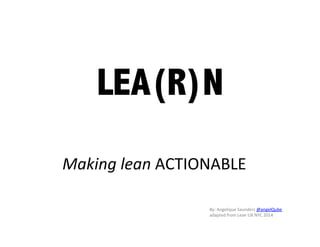Making Lean Actionable - Lean UX NYC 2014
- 2. What weŌĆÖre asked to buildŌĆ”
- 3. Some of our guidelines ŌĆóŌĆ»build!for!every!scenario!! ŌĆóŌĆ»inconsistent!requirements! ŌĆóŌĆ»stakeholder!vs.!user!needs! ŌĆóŌĆ»too!many!features! ŌĆóŌĆ»no!key!performance!metrics!
- 4. Did you say the ŌĆ£LŌĆØ word?
- 6. How can we create thinking problem solvers?
- 7. Good ŌĆ£intrapreneursŌĆØ take baby steps, reframe things, and are subversive. ŌĆóŌĆ»ask!inquisiUve!quesUons!! ŌĆóŌĆ»support!data!for!idenU’¼üed! problem! ŌĆóŌĆ»gaps!between!the!current! system!and!the!idealized!state! ŌĆóŌĆ»create!smaller!smart!goals!
- 8. How can we change the conversation?
- 9. From ŌĆ£Build thisŌĆØ to ŌĆ£How can we measure success?ŌĆØ ŌĆóŌĆ»Declare!assumpUons! ŌĆóŌĆ»IdenUfy!constraints!! ŌĆóŌĆ»Understand!the!current!ecoQ system! ŌĆóŌĆ»DemocraUze!the!product! vision!
- 10. How can we get from doubt to certainty?
- 11. Learning from our experiments ŌĆóŌĆ»quick!and!small!version! iteraUons! ŌĆóŌĆ»conUnuous!improvements!! ŌĆóŌĆ»failure!part!of!the!process! ŌĆóŌĆ»analyze!user!tesUng!and! metrics!
- 12. How can we design for the right now ?
- 14. Lean is not about action, assumptions or jumping to conclusions.
- 15. Lean is about making things actionable. ŌĆóŌĆ» All!designed!elements!should!challenge! assumpUons! ŌĆóŌĆ» Benchmark!success!with!measurable! goals! ŌĆóŌĆ» Iterate!with!MVP!test!builds!and!assess! feedback! ŌĆóŌĆ» The!idealized!design!thrives!and!adapts! within!a!complex!system!
















